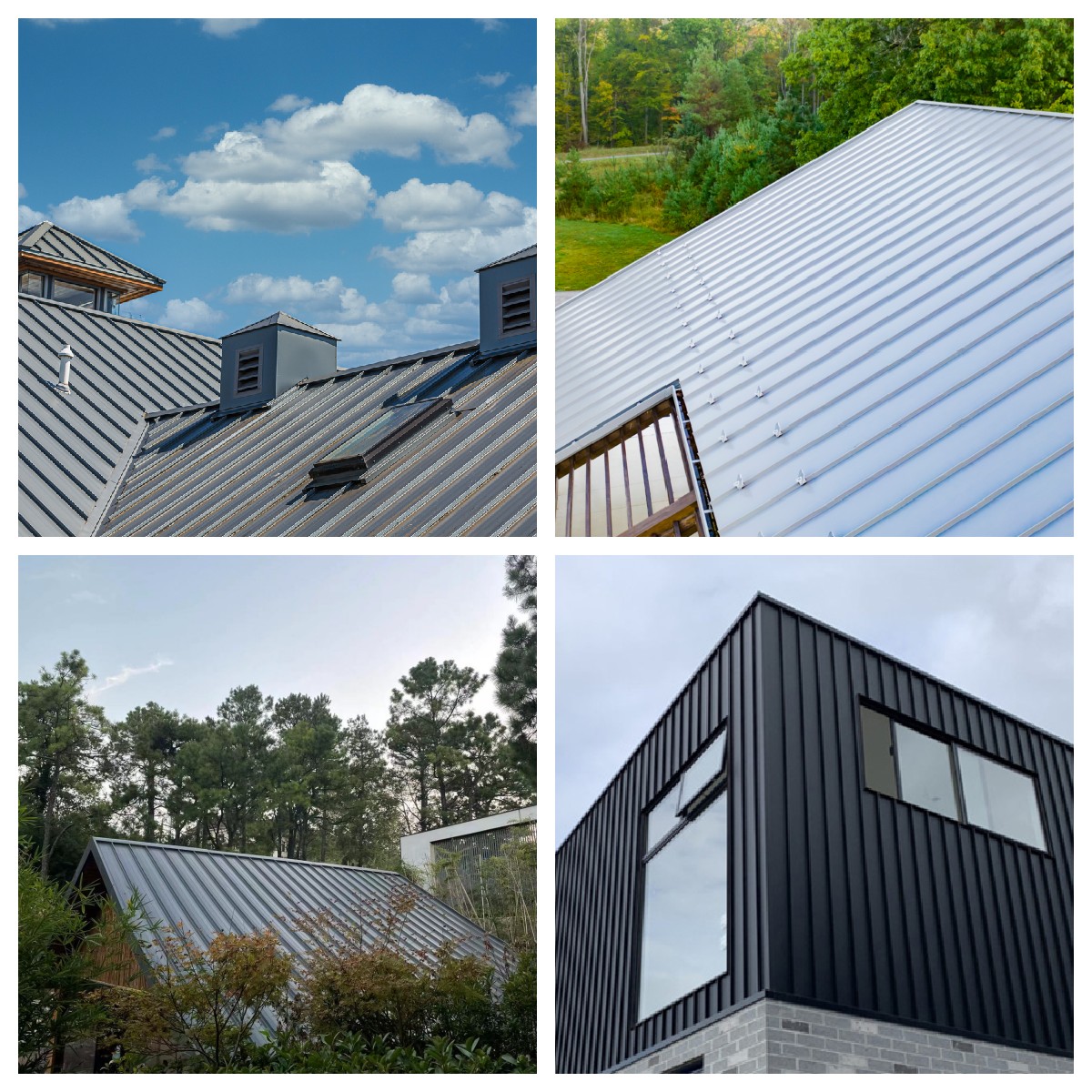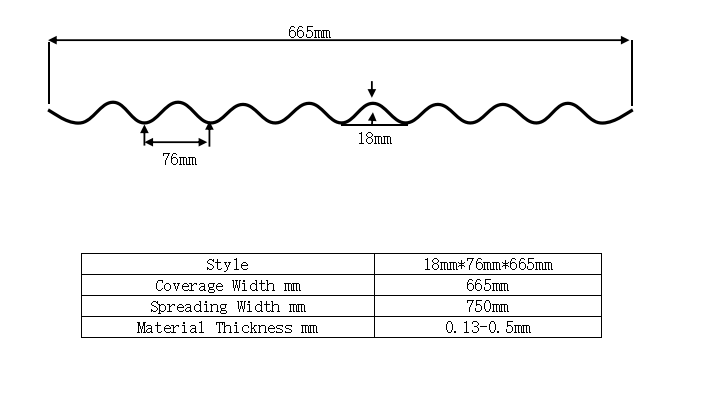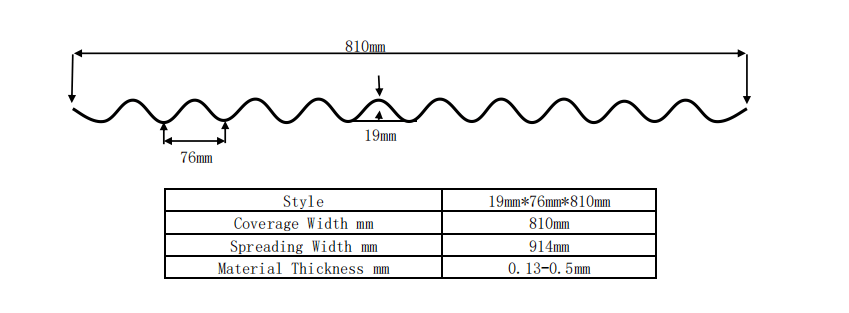Corrugated
Dingang
7610900000
| Availability: | |
|---|---|
| Quantity: | |
| Product Name | Aluminium Roofing Sheet |
| Size | Thickness: 0.2-1.5MM Width: 650-1050 MM Length: 1000-12000 MM |
| Tolerance | Thickness: +/-0.02mm, Width:+/-2mm |
| Typical Grade | 1050,1060,1100,2024,2240,3003,5052,5754... |
| Standard | ASTM,DIN,JIS,BS,GB/T |
| Certificate | ISO, SGS, BV.... |
| Packing | standard export package (waterproof kraft paper) |
| Application | - Chemical industry equipment,Industrial Tanks -Medical equioment,Food industry,Construction,Kitchen utensils - Electricequipment,Building Material - Reflector,Mirror,Interior-Exterior decoration for building |

HOW TO INSTALL ROOFING SHEETS
Materials and Tools You'll Need:
1.Painted aluminum roofing sheets
2.Roofing underlayment (such as felt or synthetic underlayment)
3.Roofing nails or screws
4.Roofing adhesive/sealant
5.Roofing nails or screws
6.Metal cutting tools (tin snips, circular saw with a metal-cutting blade)
7.Measuring tape
8.Chalk line
9.Roofing safety equipment (harness, hard hat, non-slip shoes, etc.)
10.Ladder or scaffolding
11.Screw gun or hammer
Installation Steps:
1.Prepare the Roof: Ensure that the roof deck is clean, dry, and free from debris. Repair any damaged areas and make sure the roof's structure is sound.
2.Install Underlayment: Apply roofing underlayment to the entire roof surface according to the manufacturer's instructions. This helps to provide an additional layer of protection against water infiltration.
3.Measure and Plan: Measure the dimensions of the roof and calculate the number of roofing sheets you'll need. Plan the layout to minimize the number of cuts required. Use a chalk line to mark reference lines for the first row of roofing sheets.
4.Cutting: Use metal cutting tools to cut the aluminum roofing sheets to the required lengths and shapes. Make sure to wear appropriate safety gear when cutting metal.
5.Start Installation: Begin at the lower edge of the roof and work your way up. Align the first sheet with the chalk line and the roof's edge. Leave a slight overhang at the eaves, which can be trimmed later.
6.Fasten Sheets: Attach the roofing sheets using roofing nails or screws. Use fasteners with neoprene washers or gaskets to prevent water penetration. Fasten the sheets according to the manufacturer's recommendations, usually along the raised ridges of the sheets.
7.Overlap: When installing subsequent sheets, overlap each sheet by the recommended amount to ensure proper water shedding. The exact overlap may vary depending on the profile of the roofing sheets.
8.Sealing: Apply roofing adhesive or sealant along the overlapping edges and under the screw heads to create a watertight seal.
9.Ridge and Flashing: Install ridge caps at the peak of the roof and any necessary flashing to seal around roof penetrations such as vents, chimneys, and skylights.
10.Trimming: Once all the sheets are in place, trim any excess overhang at the eaves using metal cutting tools.
11.Finishing Touches: Inspect the entire installation for any loose fasteners, gaps, or imperfections. Make sure that all seams are properly sealed and that the roof is secure.
Painted steel sheet VS Painted aluminum sheet
Painted steel sheets and painted aluminum sheets are two different types of roofing materials, each with their own unique characteristics, advantages, and considerations. Let’s compare them based on various factors:
1. Weight:
Painted Aluminum Sheet: Aluminum is lightweight, making it easier to handle and install. This can lead to lower installation costs and reduced stress on the roof structure.
Painted Steel Sheet: Steel is heavier than aluminum, which can make handling and installation more labor-intensive.
2. Corrosion Resistance:
Painted Aluminum Sheet: Aluminum has a natural resistance to corrosion due to its oxide layer. This makes it well-suited for coastal or humid environments.
Painted Steel Sheet: Steel is prone to rusting over time unless properly coated and maintained. Galvanized or coated steel is used to improve its corrosion resistance.
3. Durability:
Painted Aluminum Sheet: Aluminum is generally more durable in terms of resisting corrosion, especially in aggressive environments.
Painted Steel Sheet: While steel can be coated to enhance its durability, it may still be more susceptible to corrosion compared to aluminum.
4. Thermal Expansion:
Painted Aluminum Sheet: Aluminum has a higher coefficient of thermal expansion than steel, which means it expands and contracts more with temperature changes. This can lead to potential issues if not accounted for during installation.
5. Strength:
Painted Aluminum Sheet: Aluminum is less dense than steel, so it is not as strong. This may impact its ability to withstand heavy loads or impacts.
Painted Steel Sheet: Steel is stronger than aluminum and is better suited for applications where structural strength is critical.
6. Aesthetics:
Both aluminum and steel can be painted in a variety of colors and finishes, offering flexibility in terms of aesthetics.
7. Environmental Impact:
Painted Aluminum Sheet: Aluminum is considered more environmentally friendly due to its high recyclability and lower energy requirements for extraction and production.
Painted Steel Sheet: While steel can also be recycled, its production processes tend to be more energy-intensive.
8. Noise and Insulation:
Painted Aluminum Sheet: Aluminum tends to be noisier during rain and other impact events compared to steel. It also offers less insulation.
Painted Steel Sheet: Steel provides more insulation against noise and temperature variations.
How to packing and shipping when export
Inspect the Painted Aluminum Sheets: Before packing, inspect the painted aluminum sheets for any damage, scratches, or imperfections. Only pack sheets that meet quality standards.
Clean the Sheets: Ensure that the painted surface is clean and free from dust, dirt, and debris. Use a soft cloth or a gentle cleaning solution if necessary.
Protective Coating: If the painted surface is sensitive, consider applying a protective coating or film to prevent scratches during handling and shipping.
Materials Needed: Gather the necessary packing materials, including:
Cardboard or Wooden Crates: These provide sturdy protection for the sheets.
Bubble Wrap: Use bubble wrap to wrap individual sheets and provide cushioning.
Corner Protectors: These protect the edges of the sheets from impact.
Foam or Styrofoam Sheets: Place foam sheets between layers of painted aluminum sheets to prevent direct contact.
Plastic Sheeting: Use plastic sheeting to shield the sheets from moisture.
Strapping or Packing Tape: Secure the packaging materials in place.
Wrapping Individual Sheets:
Place a sheet of bubble wrap on a flat surface.
Gently place the painted aluminum sheet on the bubble wrap.
Wrap the sheet tightly in the bubble wrap, ensuring all edges are covered.
Secure the bubble wrap in place with packing tape.
Creating Layers:
Place foam or Styrofoam sheets on the bottom of the crate.
Carefully stack the wrapped aluminum sheets in a single layer on top of the foam sheets.
Place corner protectors on the top of the first layer.
Adding Additional Layers:
Add another layer of foam or Styrofoam sheets on top of the first layer of aluminum sheets.
Place the next layer of wrapped aluminum sheets on top of the foam, alternating the placement to avoid direct alignment of corners.
Continue this process until all sheets are packed, placing foam between each layer.
Securing and Sealing:
Once all layers are stacked, place foam on top.
Seal the crate with packing tape.
Use strapping to reinforce the crate's structure.
Shipping:
Labeling: Clearly label the crate with shipping information, including addresses and contact details. Include handling instructions if necessary.
Customs Documentation: Ensure that you have all the necessary customs documentation, such as invoices, export permits, and certificates of origin.
Shipping Method: Choose a shipping method that suits your budget and timeline, considering factors like air freight, sea freight, or land transportation.
Insurance: Consider insuring the shipment to protect against damage or loss during transit.
Tracking: If available, use shipment tracking services to monitor the progress of your shipment.
Communication: Keep lines of communication open with the recipient to ensure they are prepared to receive the shipment and can coordinate with customs clearance if required.
By following these steps and paying close attention to the packaging and shipping process, you can increase the likelihood of your painted aluminum sheets arriving at their destination in good condition. It's also a good idea to consult with shipping experts or professionals who specialize in exporting goods to ensure you meet all requirements and regulations.

Size of Corrugated Aluminum Sheet


Welcome to contact us for more product details.
| Product Name | Aluminium Roofing Sheet |
| Size | Thickness: 0.2-1.5MM Width: 650-1050 MM Length: 1000-12000 MM |
| Tolerance | Thickness: +/-0.02mm, Width:+/-2mm |
| Typical Grade | 1050,1060,1100,2024,2240,3003,5052,5754... |
| Standard | ASTM,DIN,JIS,BS,GB/T |
| Certificate | ISO, SGS, BV.... |
| Packing | standard export package (waterproof kraft paper) |
| Application | - Chemical industry equipment,Industrial Tanks -Medical equioment,Food industry,Construction,Kitchen utensils - Electricequipment,Building Material - Reflector,Mirror,Interior-Exterior decoration for building |

HOW TO INSTALL ROOFING SHEETS
Materials and Tools You'll Need:
1.Painted aluminum roofing sheets
2.Roofing underlayment (such as felt or synthetic underlayment)
3.Roofing nails or screws
4.Roofing adhesive/sealant
5.Roofing nails or screws
6.Metal cutting tools (tin snips, circular saw with a metal-cutting blade)
7.Measuring tape
8.Chalk line
9.Roofing safety equipment (harness, hard hat, non-slip shoes, etc.)
10.Ladder or scaffolding
11.Screw gun or hammer
Installation Steps:
1.Prepare the Roof: Ensure that the roof deck is clean, dry, and free from debris. Repair any damaged areas and make sure the roof's structure is sound.
2.Install Underlayment: Apply roofing underlayment to the entire roof surface according to the manufacturer's instructions. This helps to provide an additional layer of protection against water infiltration.
3.Measure and Plan: Measure the dimensions of the roof and calculate the number of roofing sheets you'll need. Plan the layout to minimize the number of cuts required. Use a chalk line to mark reference lines for the first row of roofing sheets.
4.Cutting: Use metal cutting tools to cut the aluminum roofing sheets to the required lengths and shapes. Make sure to wear appropriate safety gear when cutting metal.
5.Start Installation: Begin at the lower edge of the roof and work your way up. Align the first sheet with the chalk line and the roof's edge. Leave a slight overhang at the eaves, which can be trimmed later.
6.Fasten Sheets: Attach the roofing sheets using roofing nails or screws. Use fasteners with neoprene washers or gaskets to prevent water penetration. Fasten the sheets according to the manufacturer's recommendations, usually along the raised ridges of the sheets.
7.Overlap: When installing subsequent sheets, overlap each sheet by the recommended amount to ensure proper water shedding. The exact overlap may vary depending on the profile of the roofing sheets.
8.Sealing: Apply roofing adhesive or sealant along the overlapping edges and under the screw heads to create a watertight seal.
9.Ridge and Flashing: Install ridge caps at the peak of the roof and any necessary flashing to seal around roof penetrations such as vents, chimneys, and skylights.
10.Trimming: Once all the sheets are in place, trim any excess overhang at the eaves using metal cutting tools.
11.Finishing Touches: Inspect the entire installation for any loose fasteners, gaps, or imperfections. Make sure that all seams are properly sealed and that the roof is secure.
Painted steel sheet VS Painted aluminum sheet
Painted steel sheets and painted aluminum sheets are two different types of roofing materials, each with their own unique characteristics, advantages, and considerations. Let’s compare them based on various factors:
1. Weight:
Painted Aluminum Sheet: Aluminum is lightweight, making it easier to handle and install. This can lead to lower installation costs and reduced stress on the roof structure.
Painted Steel Sheet: Steel is heavier than aluminum, which can make handling and installation more labor-intensive.
2. Corrosion Resistance:
Painted Aluminum Sheet: Aluminum has a natural resistance to corrosion due to its oxide layer. This makes it well-suited for coastal or humid environments.
Painted Steel Sheet: Steel is prone to rusting over time unless properly coated and maintained. Galvanized or coated steel is used to improve its corrosion resistance.
3. Durability:
Painted Aluminum Sheet: Aluminum is generally more durable in terms of resisting corrosion, especially in aggressive environments.
Painted Steel Sheet: While steel can be coated to enhance its durability, it may still be more susceptible to corrosion compared to aluminum.
4. Thermal Expansion:
Painted Aluminum Sheet: Aluminum has a higher coefficient of thermal expansion than steel, which means it expands and contracts more with temperature changes. This can lead to potential issues if not accounted for during installation.
5. Strength:
Painted Aluminum Sheet: Aluminum is less dense than steel, so it is not as strong. This may impact its ability to withstand heavy loads or impacts.
Painted Steel Sheet: Steel is stronger than aluminum and is better suited for applications where structural strength is critical.
6. Aesthetics:
Both aluminum and steel can be painted in a variety of colors and finishes, offering flexibility in terms of aesthetics.
7. Environmental Impact:
Painted Aluminum Sheet: Aluminum is considered more environmentally friendly due to its high recyclability and lower energy requirements for extraction and production.
Painted Steel Sheet: While steel can also be recycled, its production processes tend to be more energy-intensive.
8. Noise and Insulation:
Painted Aluminum Sheet: Aluminum tends to be noisier during rain and other impact events compared to steel. It also offers less insulation.
Painted Steel Sheet: Steel provides more insulation against noise and temperature variations.
How to packing and shipping when export
Inspect the Painted Aluminum Sheets: Before packing, inspect the painted aluminum sheets for any damage, scratches, or imperfections. Only pack sheets that meet quality standards.
Clean the Sheets: Ensure that the painted surface is clean and free from dust, dirt, and debris. Use a soft cloth or a gentle cleaning solution if necessary.
Protective Coating: If the painted surface is sensitive, consider applying a protective coating or film to prevent scratches during handling and shipping.
Materials Needed: Gather the necessary packing materials, including:
Cardboard or Wooden Crates: These provide sturdy protection for the sheets.
Bubble Wrap: Use bubble wrap to wrap individual sheets and provide cushioning.
Corner Protectors: These protect the edges of the sheets from impact.
Foam or Styrofoam Sheets: Place foam sheets between layers of painted aluminum sheets to prevent direct contact.
Plastic Sheeting: Use plastic sheeting to shield the sheets from moisture.
Strapping or Packing Tape: Secure the packaging materials in place.
Wrapping Individual Sheets:
Place a sheet of bubble wrap on a flat surface.
Gently place the painted aluminum sheet on the bubble wrap.
Wrap the sheet tightly in the bubble wrap, ensuring all edges are covered.
Secure the bubble wrap in place with packing tape.
Creating Layers:
Place foam or Styrofoam sheets on the bottom of the crate.
Carefully stack the wrapped aluminum sheets in a single layer on top of the foam sheets.
Place corner protectors on the top of the first layer.
Adding Additional Layers:
Add another layer of foam or Styrofoam sheets on top of the first layer of aluminum sheets.
Place the next layer of wrapped aluminum sheets on top of the foam, alternating the placement to avoid direct alignment of corners.
Continue this process until all sheets are packed, placing foam between each layer.
Securing and Sealing:
Once all layers are stacked, place foam on top.
Seal the crate with packing tape.
Use strapping to reinforce the crate's structure.
Shipping:
Labeling: Clearly label the crate with shipping information, including addresses and contact details. Include handling instructions if necessary.
Customs Documentation: Ensure that you have all the necessary customs documentation, such as invoices, export permits, and certificates of origin.
Shipping Method: Choose a shipping method that suits your budget and timeline, considering factors like air freight, sea freight, or land transportation.
Insurance: Consider insuring the shipment to protect against damage or loss during transit.
Tracking: If available, use shipment tracking services to monitor the progress of your shipment.
Communication: Keep lines of communication open with the recipient to ensure they are prepared to receive the shipment and can coordinate with customs clearance if required.
By following these steps and paying close attention to the packaging and shipping process, you can increase the likelihood of your painted aluminum sheets arriving at their destination in good condition. It's also a good idea to consult with shipping experts or professionals who specialize in exporting goods to ensure you meet all requirements and regulations.

Size of Corrugated Aluminum Sheet


Welcome to contact us for more product details.
Products
Quick Links
Contact Us
